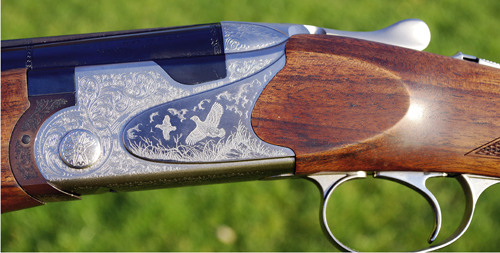Beretta SV10 shotgun review

Beretta SV10 shotgun review
Manufacturer: Beretta
Beretta SV10 shotgun review.
When a major gunmaker like Beretta comes out with a new model, it?s always interesting.
Often, on close inspection, a new model transpires to be nothing more than a revamp of an existing one.
On much rarer occasions, it is a completely re-engineered product.
The Perennia falls into the latter category and it is based on the recently developed SV10 series action, upon which Beretta intend to build a new range of guns. There will soon be a sporter as well.
The Perennia has some familiar features which link it to the old 55 and 600 series guns, such as trapezoidal barrel shoulders and conical locking bolts. But, it is an entirely new design. Save for a few small bits of the mechanism, like sears and hammers and inertia block, the parts are not interchangeable as they are throughout most of the 600/Silver Pigeon range.
For example, the Perennia trapezoidal barrel shoulders are a different size and shape to other Berettas. I had the chance to test fire an early production Perennia some time ago. It had a conventional stock, and, some reservations about styling apart, I was greatly impressed with it.
It shot extremely well.
First impressions of the test gun are generally positive too. Unlike the Perennia I tried previously, however, this one is fitted with a Kick-Off hydraulic recoil reduction system.
This is a telescoping shock absorbing device, which is fitted to the rear of the stock much like a recoil pad. This not only gives the gun a distinct look, but makes it a bit butt heavy.
This is unusual in a mass-produced, multi-choked, over-under, but not necessarily a negative. Indeed many guns today are far too muzzle heavy. It is also notable that the test Perennia is equipped with 28″ Optima-bored barrels which are not only slightly over-bored, but lighter than the average.

Lively tubes are usually my preference in a 12-bore game model. I would suspect, moreover, that 30″ tubes might balance out almost perfectly with the Kick-Off mechanism.
The barrels are fitted with a 6mm ventilated rib and have 3″ (76mm) chambers. Joining ribs only extend back as far as the fore-end. The Opti-choke multi-chokes are flush fitting and of a type that is longer than the older Beretta type.
I have found the Optima barrel package ? wider bores, long chokes and extended forcing cones ? really does show a significant improvement in pattern performance.
It seems to create a pattern that has less central concentration and which is more efficient at its fringes. In simple terms, one can use one less choke constriction without any ballistic loss and the potential benefit of a more forgiving, wider, but no less effective pattern.
Barrel making, as one expects from Beretta, is very sound in all departments. The barrels are well presented and free from heat distortion or rivel. The tubes, like the monobloc into which they are inserted, are made from Chrome-Moly steel.
I know of no other manufacturer that makes barrels that are more durable or more consistent.
The test Perennia was fitted with a forward sling swivel, which is attached by machine screws and might easily be removed should Continental hunters still prefer them.
The action of the Perennia is outwardly similar to the 600 series save for asymmetric scalloping to its rear and the larger, re-shaped, trapezoidal barrel shoulders. It appears that the Beretta designers have set out with a brief to take the 600 and strengthen it, as well as to re-sculpture the action body to make the gun look rather more modern.

There are also a number of significant mechanical changes.
There is not, for example, the usual long stock bolt as seen in nearly all modern machine made over-unders. Instead a much shorter bolt emerges from the rear of the action and goes only a few inches back.
One pushes a key through a hinged trap door in the base of the grip and can easily remove the stock. With the stock off, and using the same tool, the trigger mechanism can be taken out as well.
The safety of the Perennia has also been substantially redesigned (inspired by that of the DT10) and seems more positive in action. There is a new fore-end iron, and, a new ejection system. The ejectors may be turned on and off. This is a useful feature for those who shoot pigeons or wildfowl or walked-up game birds, as you don?t have to pick the spent shells off the ground.
As well as this there is a sprung self-tightening mechanism within the fore-end. Something rather similar was once seen in Franchis. The stock of the Perennia – made from quite plain wood – is pretty typical of modern Berettas. But there have been subtle changes.

There is a fairly wide radius pistol grip of sensible pattern and a comb profile that is comfortable yet not too bulky. Laser chequering on the grip and the field style, lip-free, fore-end are neat and practical.
SHOOTING IMPRESSIONS
I was a bit disappointed with the way the Kick-Off equipped Perennia handled. I tried it on simulated game layouts and it broke the birds beautifully.
The Optima package really seems to do the business with regard to terminal effect but the gun seemed to bounce in the shoulder because of its recoil reduction mechanism.
There was some reduction in felt recoil, but I found this bouncing and the physical effect of the stock compressing on firing unnerving.
The Perennia SV10 is an excellent new gun, but I don?t think it is improved by the addition of the Kick-Off system. Happily, it is available without it.
Beretta SV10 Perennia shotgun
Around £2,475








